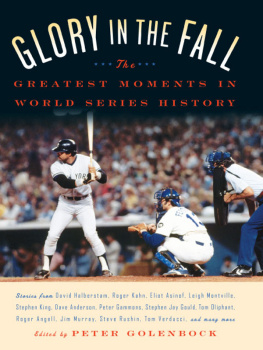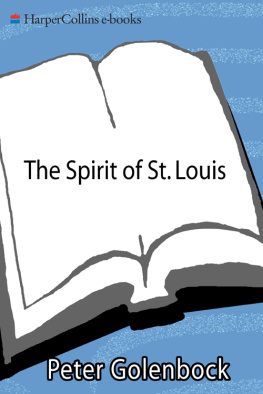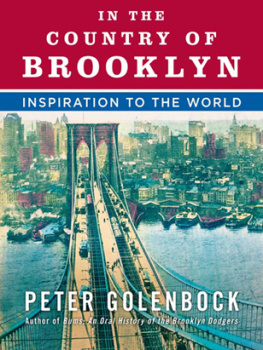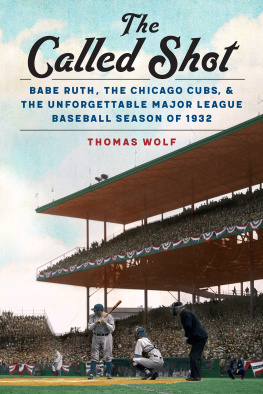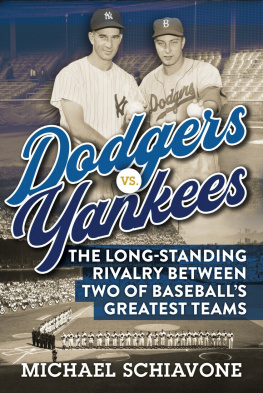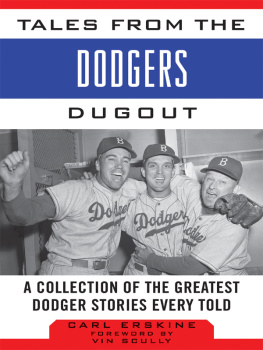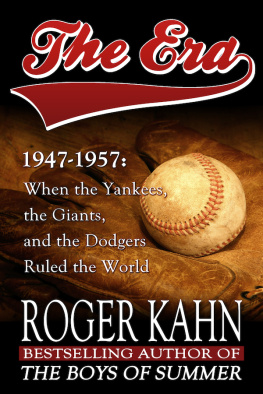STERLING and the distinctive Sterling logo are registered trademarks of Sterling Publishing Co., Inc.
Published by Sterling Publishing Co., Inc.
387 Park Avenue South, New York NY 10016
2010 by Sterling Publishing Co., Inc.
Distributed in Canada by Sterling Publishing
c/o Canadian Manda Group, 165 Dufferin Street
Toronto, Ontario, Canada M6K 3H6
Distributed in the United Kingdom by GMC Distribution Services
Castle Place, 166 High Street, Lewes, East Sussex, England BN7 1XU
Distributed in Australia by Capricorn Link (Australia) Pty. Ltd.
P.O. Box 704, Windsor, NSW 2756, Australia
For information about custom editions, special sales, premium and corporate purchases, please contact Sterling Special Sales Department at 800-805-5489 or specialsales@sterlingpublishing.com
I was just a boy when I discovered living baseball history in the stacks of the Stamford (Connecticut) Public Library. I had no idea who Frank Graham, Fred Lieb, or Roy Stockton were, but, because of them, I was able to get to know Babe Ruth, Ty Cobb, the Gas House Gang, and Tinker to Evers to Chance. I read about the Black Sox scandal, and how Judge Landis saved baseball. I wasnt told that Landis had single-handedly kept Negroes, as they were called then, out of baseball, but this was the late 1950s, before the civil rights movement had even begun.
I recall watching baseball on television for the first time in 1954. We had a Dumont TV, a big hunk of a box. The picture was in black and white, and that year I watched Willie Mays make his incredible catch against the Cleveland Indians in the World Series. The next year I watched my Yankees lose the Series to Johnny Podres, Sandy Amoros, and the rest of the Brooklyn Dodgers.
An October later, in 1956, when I was ten, my Uncle Justin took me to the fourth game of the World Series. The game was played at Yankee Stadium, and I watched as the Yankees defeated the Dodgers 42. Mickey Mantle hit a home run. After the game, Uncle Justin said that he had to go see Jackie Robinson before we went home. Uncle Justin was Jackies lawyer; Jackie was moving into a new home in Stamford, and there was something they had to talk about. I shook hands with Jackie. He was a large man with huge hands. I felt as though I were meeting royalty. I have spent the rest of my life thinking about him and what he went through.
Despite becoming a TV addict, I never stopped reading. In high school I discovered SPORT, a magazine that boasted some of the best writers ever to put pen to paper. Roger Kahn, Arnold Hano, and Ed Linn were my heroes. (Kahn and Linn later became friends.) They wrote biographies of the star baseball players. Around this time, a series of terrific books came out: The Pennant Race, by Jim Brosnan; Eight Men Out, by Eliot Asinof; and TheGlory of Their Times, by Larry Rittner, which I still feel is the greatest book on baseball ever written.
I admit it: All my life I have been a baseball junkie. No sport has a richer history than baseball, and no sport has such a treasure trove of books, magazine articles, and newspaper accounts. Over the years, I have tried to read everything I could.
And no sport has provided as many moments in its championship series as baseball. There is no sporting event quite like the World Series. During those two weeks in Octoberand now extending into Novembertime stands still. Nothing else matters.
Off the top of my head, if you asked me which were the greatest World Series moments, Id have to start with Don Larsens perfect game; Willie Mayss catch; Carlton Fisks home run; Babe Ruths called shot; Bill Mazerowskis home run; Ron Swobodas catch; the ball that went through Bill Buckners legs; Joe Carters home run; and the Tampa Bay Rays playing in the 2008 World Series. I know. Kirk Gibsons home run off Mitch Williams is far more important, but if you had been a Rays fan as long as I had, youd understand. For those of us who live in Tampa Bay, we will always have the 2008 World Series.
My guess is that you have another list, equally worthy. There hasnt been a book that combines the writing of the acclaimed sportswriters with the high drama and the rich history of the World Series until now. Glory in the Fall is that book.
On these pages we get to read the work of Roger Angell, Peter Gammons, Robert Creamer, Stephen Jay Gould, and David Halberstam, to name a few among many, many other talented writers, as they bring alive great moments in World Series history. We can read about Bostons Royal Rooters and their impact on the very first World Series in 1903, and relive what in 1904 was called the most costly wild pitch in history, Jack Chesbros throw, which cost the Yankees a chance to go to the Series that year. Of course, that Series never took place, because New York Giants manager John McGraw didnt want to risk losing to the Red Sox, the team that had won the year before. As a result, the Red Sox could claim that they were still world champs.
I had the good fortune to interview Joe Cashman, a reporter who remembered the 1912 World Series. He covered the Red Sox, and he claimed that the outfield of Duffy Lewis, Tris Speaker, and Harry Hooper was the greatest of all time. Eliot Asinof was able to interview a number of the players accused of throwing the 1919 World Series. It is because of Asinof that we know the details of that sordid story.
Robert Creamer recalls the heroics of Giants outfielder Casey Stengel in the 1923 World Series. Not only did Stengel hit two home runs to win games, but as he was scoring after hitting the second one, he thumbed his nose at the Yankees dugout. That winter Stengel was the most famous man in America. A month later, manager McGraw traded him to the Boston Braves. Stengel would return to the World Series twenty-six years later. He would return time and time again.
The World Series has been full of surprises, the most astounding perhaps the time As manager Connie Mack started journeyman Howard Ehmke in Game 1 of the 1929 World Series against the powerful Chicago Cubs. Mack had Lefty Grove, George Earnshaw, and Rube Walberg, but the Cubs were a fastball-hitting team, and Ehmke threw junk; Mack figured that the Cubs would be thrown off their game. Ehmke struck out 13 and won the game. Later in that Series, the Cubs would lead Game 4 by a score of 80, only to see the As score 10 runs in the seventh inning. This was the greatest rally in World Series history.
Babe Ruths so-called Called Shot came off Charlie Root in the third game of the 1932 Series. The story was that Ruth was furious with the Cubs for not giving former Yankee teammate Mark Koenig a full share of the World Series proceeds. But that may not be the real reason. The essay herein says Ruth didnt really care for Koenig; he just wanted to badger the Cubs. At the plate, he called them names. He pointed somewhereto the dugout or to the center-field bleachers?and then he hit a home run. This was the most famous home run in World Series history, and we get to read Paul Gallico and Westbrook Peglers account of what happened.
The most dazzling performance by two brothers occurred in the 1934 World Series when Dizzy and Paul Dean won all the games for the Cardinals against the Detroit Tigers. Ten years later, the Cardinals again were in the Series, this time against the St. Louis Browns. Once again, the surprise choice of Denny Galehouse to start the first game for the Browns was the talk of the Series. In 1946, the Cards Enos Slaughter made himself immortal with his mad dash from first on a single.

